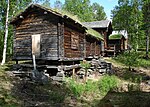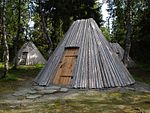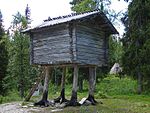Kirchendorf (Sweden)

Kirchendorf ( Swedish kyrkstad , literally church town ) is the name in northern and central Sweden for a collection of huts, stables and storehouses around a church that were used for occasional church visits.
Use and dissemination
The parishes in central and north Sweden were very large. The parish (socken) Luleå with its church in today's Gammelstad included z. B. at times an area of over 90,000 km² and was therefore larger than Austria . It was therefore difficult for churchgoers who lived further away to go to church and back home within one day . Instead, they only attended church on certain holidays, staying in their own hut for a few days and taking the opportunity to settle other matters and do business.
The construction of church villages or church huts and church houses (with several "apartments") was regulated by law from the end of the 17th century. Church huts were reserved for the landowners, and they also had to have their permanent place of residence at a minimum distance from the church (usually a Scandinavian mile , originally a good 10 km). In the 19th century, the construction of new church huts was limited to the two northernmost provinces, Norrbottens län and Västerbottens län (including the shares in Lapland ). A church hut often also had a stable and a storage building, but these are mostly demolished today. There were church villages in almost all parishes in northern Sweden.
In central Sweden, where the distances were not so great, church stables were often located near the church, in which the worshipers could also spend the night if necessary. However, these were only intended for the sheltering of horses, for example, which is why assemblies of church stables are not counted as church villages in the narrower sense.
The church villages built by farmers (Swedish bonde ) were often also referred to as Bondstad , while the church villages used by the Sami (historically Lappen ) and predominantly made up of traditional feces - Lappstad. There were also a smaller number of church villages (lappstäder) in parts of Lapland that do not belong to today's Sweden, for example in Sodankylä , Utsjoki and Inari in Finland and Karasjok and Kautokeino in Norway .
List of church villages
In total there were about 70 church villages in Sweden, of which only 16 have survived on a larger scale. The largest church village is in Gammelstad near Luleå and was declared a World Heritage Site in 1996 . Around 1817 it consisted of 484 church huts, 359 horse stables and other buildings. Nine church villages are declared as cultural assets of imperial interest (Riksintresse för kulturmiljövården) , three as architectural monuments ( Byggnadsminne ) .
Preserved church villages in Sweden
| place |
Län Landskap |
image | details |
|---|---|---|---|
| Älvsbyn |
Norrbotten County of Norrbotten |
 |
a few dozen church houses and huts; Reich interest |
| Ammarnäs * |
Västerbotten County of Lapland |
 |
called Lapp-Plassen; twelve granaries on stilts and a church hut; Reich interest |
| Ankarede |
Jämtland County Jämtland |
 |
over 30 koten , 5 granaries and a dozen church huts |
| Arvidsjaur ** |
Norrbotten County, Lapland |
 |
called Lappstan; over 30 wood feces and over 50 stores; monument |
| ground |
Norrbotten County of Norrbotten |
 |
a few dozen church huts by Överluleå Church |
| Burträsk |
Västerbotten County Västerbotten |
three large church houses, rebuilt after a fire in 1930 | |
| Byske |
Västerbotten County Västerbotten |
eight church huts; monument | |
| Fatmomakke * |
Västerbotten County of Lapland |
 |
80 Koten and stilt storage as well as some church huts; Reich interest |
| Gammelstad |
Norrbotten County of Norrbotten |
 |
400 church huts; UNESCO World Heritage Site |
| Hortlax |
Norrbotten County of Norrbotten |
nine church huts, rebuilt after the fire in 1917; Reich interest | |
| Norrfjärden |
Norrbotten County of Norrbotten |
several dozen church huts, rebuilt after the fire in 1915; Reich interest | |
| Öjebyn ( Piteå ) |
Norrbotten County of Norrbotten |
also called Piteå Gammelstad , over 150 church huts; Reich interest | |
| Lövånger |
Västerbotten County Västerbotten |
 |
over 100 church huts; Reich interest |
| Råneå |
Norrbotten County of Norrbotten |
ten church huts | |
| Skellefteå |
Västerbotten County Västerbotten |
 |
called Bonnstan, over 100 church huts (formerly 116); partly from the 17th century; Reich interest and monument |
| Vilhelmina |
Västerbotten County of Lapland |
 |
a few dozen church huts; Reich interest |
Other church villages
All other former church villages in today's Sweden listed in Ragnar Berglings standard work (see literature ) are listed below, grouped by historical provinces (landskap) . Most of these no longer exist today or only to a limited extent (individual buildings).
- Ångermanland : Arnäsvall (Årnäs), jaw ( Fjällsjö ) Bjästa ( Nätra ) Bjurholm , Bredbyn ( Anundsjö ) Kyrktåsjö ( Tåsjö ) Nordmaling , Ramsele , Rossön (Bodum) Sidensjö , Själevad , Vallen (Grundsunda in Husum )
- Härjedalen : Lillhärdal , Sveg , Ytterhogdal
- Lapland : Arjeplog **, Åsele **, Dikanäs , Dorotea , Fredrika , Gällivare **, Gillesnuole * ( Sorsele municipality ), Jäckvik *, Jokkmokk **, Jukkasjärvi *, Karesuando *, Lycksele **, Malå **, Risbäck , Sorsele **, Stensele **, Tärnaby * (Tärna), Viktoriakyrkan * ( Sorsele municipality ), Vojtjajaure kapell * ( Storuman municipality )
- Norrbotten : Kalix (Nederkalix), Överkalix , Pajala
Remarks:
- The localities are listed with their current names, provided that the churches in question are located within localities.
- If different from the current place names, the names of the church are given in brackets, usually according to the names of the respective parish ( socken ) or the later (after 1862) parish ( församling ).
- In the case of churches outside of built-up areas, today's municipality (commun) is given in brackets .
- Church villages historically classified as lappstad are marked with *, mixed lapp- and bondstädter with ** (also in the table above ).
- Furthermore, the parishes Enontekis are * listed (in Lapland) and Nedertorneå (in Norrbotten) whose onetime territory although partially belongs to Sweden today, the churches with the associated Church Village but since 1809 the Russian Empire belonging Grand Duchy of Finland were (now Finland, according to in the municipality of Enontekiö and in the city of Tornio ; the church villages no longer exist; the church of Enontekis has been relocated several times on the Finnish side, the Swedish parish subsequently merged into the Karesuando parish ).

